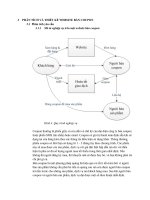Slide phân tích và thiết kế phần mềm
Bạn đang xem bản rút gọn của tài liệu. Xem và tải ngay bản đầy đủ của tài liệu tại đây (1.39 MB, 34 trang )
Design Patterns
CuuDuongThanCong.com
/>
What Are Design Patterns?
• Solutions to common problems
• Targets of refactoring, not design
• Powerful, flexible, reusable
CuuDuongThanCong.com
/>
Pattern Types
CuuDuongThanCong.com
/>
Creational Patterns
Concerned with
the creation of
objects and
instances.
CuuDuongThanCong.com
/>
Structural Patterns
Concerned with the
overall design of
the system and its
constituent classes
and objects.
CuuDuongThanCong.com
/>
Behavioral Patterns
Concerned with
the assignment
of responsibilities
to objects and
classes.
CuuDuongThanCong.com
/>
Style for Describing Patterns
• We will use this structure:
• Pattern name
• Purpose: what problem the pattern addresses
and the general approach of the pattern
• UML for the pattern
• Participants: a description as a class diagram
• Use Example(s): examples of this pattern, in C#
and other
CuuDuongThanCong.com
/>
Singleton
CuuDuongThanCong.com
/>
Singleton - Purpose
• This pa(ern ensures that a class has only one
instance and provides a global point of access to
it.
• Exactly one instance of a class is required.
• Controlled access to a single object is
necessary
CuuDuongThanCong.com
/>
Singleton - UML
CuuDuongThanCong.com
/>
Singleton – Sample 1
Eager initialization of singleton
CuuDuongThanCong.com
/>
Singleton – Sample 2
lazy initialization of singleton
CuuDuongThanCong.com
/>
Singleton – Sample 3
Thread safe initialization of singleton
CuuDuongThanCong.com
/>
Composite
CuuDuongThanCong.com
/>
Composite - Purpose
• This pattern is used to separate an
abstraction from its implementation so that
both can be modified independently
• It is used when we need to treat a group of
objects and a single object in the same
• It creates a class contains group of its own
objects. This class provides ways to modify
its group of same objects
CuuDuongThanCong.com
/>
Composite – When to use
• Hierarchical representations of objects are
required.
• The Composite pattern is used when data is
organized in a tree structure
• A single object and a group of objects
should be treated in the same way.
CuuDuongThanCong.com
/>
Composite – UML
CuuDuongThanCong.com
/>
Composite – UML (2)
CuuDuongThanCong.com
/>
Composite – Sample
• The classes, interfaces and objects:
• IEmployed - Component Interface.
• Employee- Composite Class.
• Contractor- Leaf Class
CuuDuongThanCong.com
/>
Composite – Sample
CuuDuongThanCong.com
/>
Composite – Sample
• Project’s source code…
CuuDuongThanCong.com
/>
Composite – Sample
CuuDuongThanCong.com
/>
Prototype
CuuDuongThanCong.com
/>
Prototype - Purpose
• Create objects by cloning a prototypical instance.
• Consumes less resources than creating new objects.
CuuDuongThanCong.com
/>
Prototype – UML
CuuDuongThanCong.com
/>









